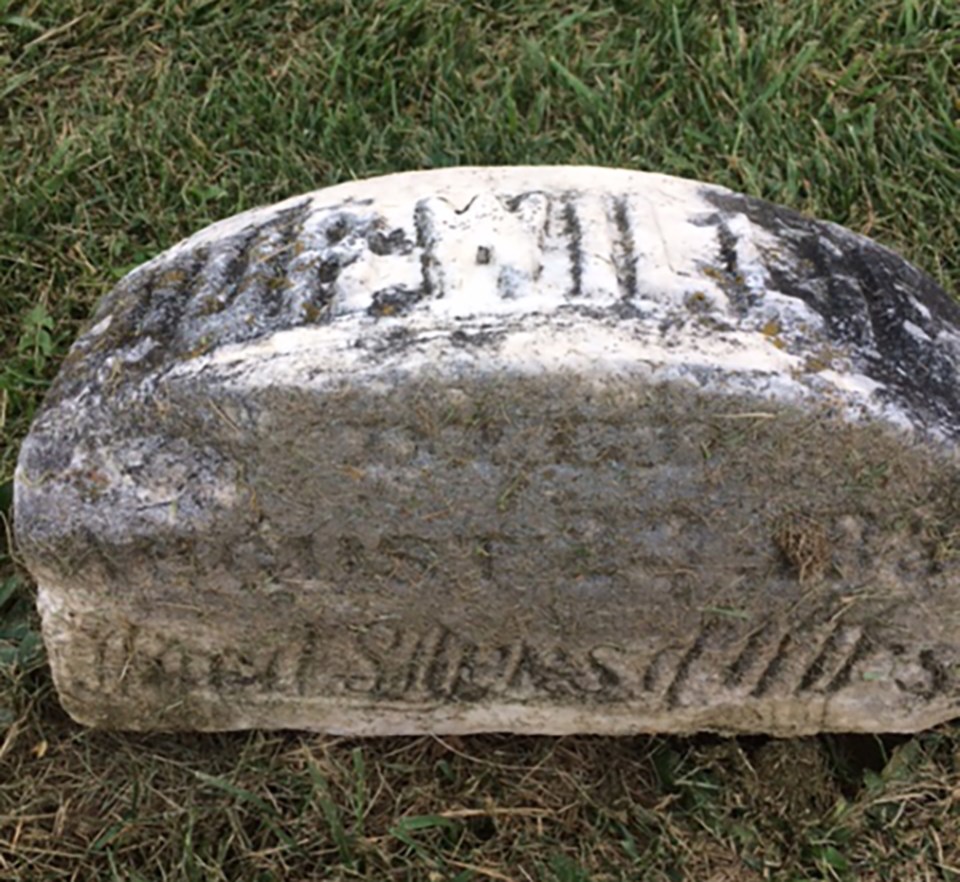The Town of Bradford West Gwillimbury has seen its share of tragedies over the years – from horrible accidents, to brutal murders. Did you know...
Alexander and Elizabeth Sutherland ran a bakery on Simcoe Road near Holland Street and Sutherland Grocery on Holland Street. In 1889, their eight-year old son William went fishing with his brother and cousins on the Holland River. The older boys went off to find a boat, leaving William by the river. When they returned, the boy was missing. Residents of Bradford searched for four days, before finding the body of the missing child. He was buried at Mount Pleasant Cemetery, where a small marker reads ‘Our Willie.' His brother Jack Sutherland was killed in Europe during the First World War.
“I read about Willie in letters between Bessie and Lewis and William L. Campbell while they were away studying at university,” says Luanne Campbell Edwards, who submitted the story to BradfordToday. “Bessie describes Willie visiting her home at various times, then describes his death. It wasn’t until I found a small trunk containing my grandfather’s study notes from university and local newspapers that I found Willie’s obituary. It appeared in the South Simcoe News.”
On April 14, 1928, a Canadian National Railway train travelling southbound through Bradford crashed as it was crossing the river. Engineer J.W. Brooks was killed when the train, heading to New York with a load of silk from Japan and frozen fish from Vancouver, derailed. He was found still in his seat. No cause for the derailment was given in the reports of the day, or determined.
Public school principal George G. Atkinson drowned when he attempted to rescue two friends who had gone through the ice on the Holland River. It was January 1933, and a skating party that included Atkinson and his wife headed out on the river – unaware that warmer temperatures had led to thin ice. Two members of the party, Bert Broderick and William Blackwell, a bank manager, were the first to break through the ice into the frigid water. Atkinson attempted to come to their rescue, fell through the ice and was swept away. The other two men managed to pull themselves from the river, suffering from hypothermia, and went to get help. OPP officer Sam Ervine and Mr. B.B. Collings rushed to the scene but were unable to locate the missing man. His body was recovered the next day. The Bradford Witness expressed sympathy for his surviving family members, including his wife, who witnessed the tragedy, and his seven-year-old son. Atkinson, 36, was a war veteran.
Five-year-old Joan Stephenson ran to get help after discovering her parents – Mr. and Mrs. F.W. “Bud” Stephenson – both dead in their bedroom, above the Bradford Bakery. A short distance away, her nine-month-old brother lay sleeping in his crib. Mrs. Stephenson, still in bed, had suffered two gunshot wounds to the head from a .22 calibre rifle. Her husband, a noted bowler and hockey player, was found on the floor next to the bed, a bullet wound in his temple, lying on top of a rifle. Const. Walter Reeves investigated. The 1940 deaths were ruled a murder-suicide, although newspaper reports said there had been “nothing unusual in his demeanor that day” that might have predicted the tragedy.
The double murder of Royal Canadian Air Force veteran Robert McKay and his wife Gloria in 1949 may have taken place just outside Bradford, even though their bodies were discovered in Toronto. The Toronto residents had been visiting relatives in Minesing, and were driving home in their 1943 Dodge Sedan. They stopped in Bradford for the local Lions Carnival and Dance, leaving around 10 p.m. They were last seen when they pulled into Winterkorn’s garage, south of the bridge on 11, for gas. Mr. Winterkorn reported seeing a second male in the car, who may have been a stranger, and later heard the sound of five shots, coming from a back road. The killer was Stanley Buckowski, a serial robber and murderer. Although he eventually confessed to the killings, he was never charged with the McKay deaths. He was executed in the U.S. in 1952 for the 1950 murder of a Los Angeles woman.
Details from the Archives of the Bradford West Gwillimbury Public Library, other online resources, and Luanne Campbell Edwards.
Do you have a little-known story about BWG? Email us the details at [email protected]





